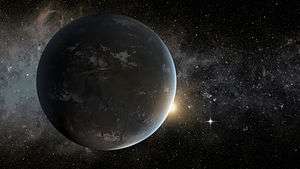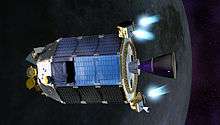Kepler-37b
| Exoplanet | List of exoplanets | |
|---|---|---|
 | ||
| Parent star | ||
| Star | Kepler-37 | |
| Constellation | Lyra | |
| Right ascension | (α) | 18h 56m 14.32s |
| Declination | (δ) | +44° 31′ 05.3″ |
| Apparent magnitude | (mV) | 9.71 |
| Distance | 215.2 ly (66 pc) | |
| Spectral type | G8V | |
| Mass | (m) | 0.80 (± 0.07) M☉ |
| Radius | (r) | 0.77 (± 0.03) R☉ |
| Temperature | (T) | 5417 (± 75) K |
| Metallicity | [Fe/H] | −0.32 (± 0.07) |
| Age | 5.66 Gyr | |
| Physical characteristics | ||
| Mass | (m) | 0.01+5.99 −0.01[1][2][3][lower-alpha 1] M⊕ |
| Radius | (r) | 0.354 (± 0.014) R⊕ |
| Stellar flux | (F⊙) | 45.53 ⊕ |
| Temperature | (T) | 700 K (427 °C; 800 °F)[4] |
| Orbital elements | ||
| Semi-major axis | (a) | 0.1003[5] AU |
| Eccentricity | (e) | 0.080+0.210 −0.080 |
| Orbital period | (P) | 13.367308[6] d |
| Inclination | (i) | 88.63[5]° |
| Discovery information | ||
| Discovery date | February 20, 2013[6] | |
| Discoverer(s) | ||
| Discovery method | Transit (Kepler Mission) | |
| Discovery site | Kepler Space Observatory | |
| Discovery status | Published | |
| Other designations | ||
| KOI-245.01, KOI-245 b, KIC-8478994 b, TYC 3131-1199-1 b | ||
| Database references | ||
| Extrasolar Planets Encyclopaedia | data | |
| SIMBAD | data | |
| Exoplanet Archive | data | |
| Open Exoplanet Catalogue | data | |
Kepler-37b is an extrasolar planet (exoplanet) orbiting Kepler-37 in the constellation Lyra.[7] As of February 2013 it is the smallest planet discovered around a main-sequence star, with a radius slightly greater than that of the Moon.[8] The measurements do not constrain its mass, but masses above a few times that of the Moon give unphysically high densities.[3]
Characteristics

Mass, radius and temperature
Kepler-37b is a sub-Earth, an exoplanet with a radius and mass smaller than Earth. Its surface temperature is 700 K (427 °C; 800 °F). Because of this, it is not expected to have an atmosphere.[4] Its radius is approximately 0.34 R⊕ (about a diameter of 3,900 kilometres (2,400 mi)), about a little larger than the Moon.[9] Due to its small size, it is very likely Kepler-37b is a rocky planet with a solid surface.[4] Furthermore, it is too hot to support liquid water on its surface.[4]
Host star
The planet orbits a (G-type) star similar to the Sun, named Kepler-37, orbited by a total of four planets. The star has a mass of 0.80 M☉ and a radius of 0.79 R☉. It has a temperature of 5417 K and is 5.66 billion years old. In comparison, the Sun is 4.6 billion years old[10] and has a temperature of 5778 K.[11]
The star's apparent magnitude, or how bright it appears from Earth's perspective, is 9.71. Therefore, it is too dim to be seen with the naked eye.
Orbit
Kepler-37b orbits its parent star at a distance of about 15 million kilometers (9.3 million miles), with a period of roughly 13 days at a distance of 0.1 AU (compared to Mercury's distance from the Sun, which is about 0.38 AU).[8] The outer two planets in the system have orbital periods[6][5] within one percent of the 8:5 and 3:1 resonances with Kepler-37b's period.
Discovery
Kepler-37b, along with two other planets, Kepler-37c and Kepler-37d, were discovered by the Kepler space telescope, which observes stellar transits.[6][4] After observing transits of Kepler-37b, astronomers had to compare it with the size of the parent star.
The size of the star was obtained using asteroseismology;[9] Kepler-37 is currently the smallest star to be studied using this process.[4] This allowed the size of Kepler-37b to be determined "with extreme accuracy".[4]
To date, Kepler-37b is the smallest planet discovered around a main-sequence star[lower-alpha 2] outside the Solar System.[8] Detection of Kepler-37b was possible due to its short orbital period, relative brightness, and low activity of its host star, allowing brightness data to average out quickly.[12] The discovery of Kepler-37b has led Jack Lissauer, a scientist at NASA's Ames Research Center, to conjecture that "such little planets are common".[4]
See also
Notes
- ↑ Masses more than a few times that of the Moon result in unphysically high densities.
- ↑ The pulsar planet PSR B1257+12 A has a comparable mass. The actual size of PSR B1257+12 A is unknown, but is likely comparable to Kepler-37b.
References
- ↑ http://kepler.nasa.gov/news/index.cfm?FuseAction=ShowNews&NewsID=256
- ↑ http://exoplanet.eu/catalog/kepler-37b/
- 1 2
- 1 2 3 4 5 6 7 8 "NASA's Kepler Mission Discovers Tiny Planet System". NASA. February 20, 2013. Retrieved February 21, 2013.
- 1 2 3 "Kepler-37 System". kepler.nasa.gov. Retrieved February 21, 2013.
- 1 2 3 4 Barclay, T.; Rowe, J. F.; Lissauer, J. J.; Huber, D.; Fressin, F.; Howell, S. B.; Bryson, S. T.; Chaplin, W. J.; Désert, J. M. (2013-02-20). "A sub-Mercury-sized exoplanet". Nature. 494 (7438): 452–4. arXiv:1305.5587
 . Bibcode:2013Natur.494..452B. doi:10.1038/nature11914. ISSN 0028-0836. PMID 23426260. Retrieved 2013-02-21.
. Bibcode:2013Natur.494..452B. doi:10.1038/nature11914. ISSN 0028-0836. PMID 23426260. Retrieved 2013-02-21. - ↑ Smallest Alien Planet Kepler-37b Explained (Infographic)
- 1 2 3 "Tiniest Planet Yet Discovered by NASA Outside our Solar System". scienceworldreport.com. February 21, 2013. Retrieved February 21, 2013.
- 1 2 "Astronomers Find the Tiniest Exoplanet Yet". Slate. February 20, 2013. Retrieved February 21, 2013.
- ↑ Fraser Cain (16 September 2008). "How Old is the Sun?". Universe Today. Retrieved 19 February 2011.
- ↑ Fraser Cain (15 September 2008). "Temperature of the Sun". Universe Today. Retrieved 19 February 2011.
- ↑ Centauri Dreams - Small Planets Confirm Kepler’s Capabilities
| Records | ||
|---|---|---|
| Preceded by PSR B1257+12 A |
Least massive exoplanet 2013— |
Succeeded by current |
| Preceded by Kepler-42 d |
Smallest-radius exoplanet 2013— |
Succeeded by current |
Coordinates: ![]() 18h 56m 14.32s, +44° 31′ 05.3″
18h 56m 14.32s, +44° 31′ 05.3″


